2018 Kia Niro Plug-In Hybrid
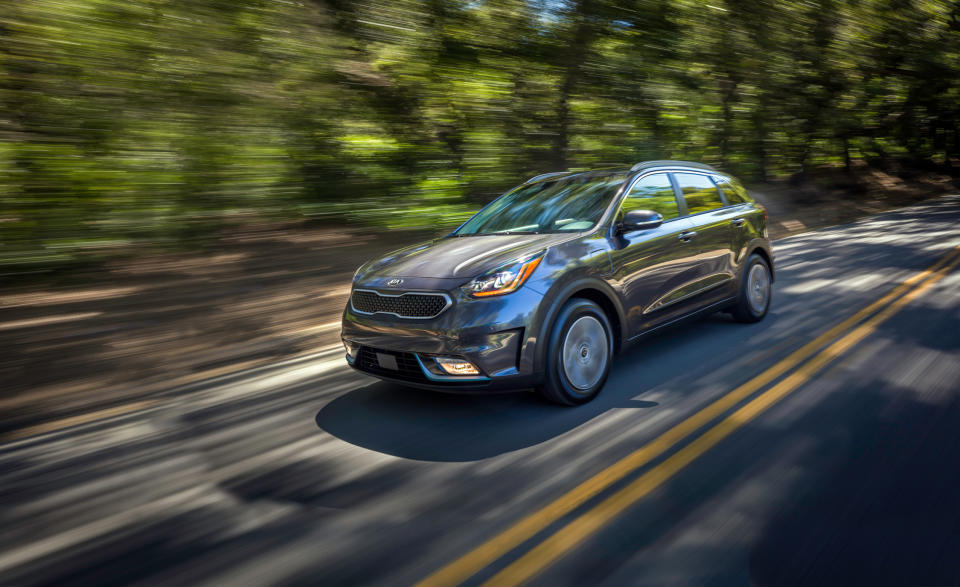
The idea is simple: Plug it in when you can, and your visits to the pump will become less frequent. That’s probably the way plug-in hybrids like the Kia Niro should be pitched to car buyers. As much as regulators and policy makers revere PHEVs and see them as an important step on the way to electric mobility, the reality is that too often the format can involve glaring compromises—excess weight, sluggish performance, and higher cost, all for the sake of the occasional delivery of a few miles of electric driving.
The best plug-in hybrids sell themselves on low running costs and not overcomplicating things, and that’s exactly what Kia has done with this Niro. The carmaker has managed to fit an 8.9-kWh battery under the back seat without encroaching on seating or cargo space. There’s a 3.3-kW onboard charger capable of providing a full charge in about 2.5 hours with a common Level 2 commercial charger (or about nine hours with a 120-volt wall socket). Compared with the regular, non-plug-in Niro hybrid, the PHEV also has upgraded power electronics and a stronger electric motor—good for 60 horsepower versus 43. Total output remains 139 horsepower and 195 lb-ft, but there’s enough electrified muscle to reach 75 mph in EV mode.
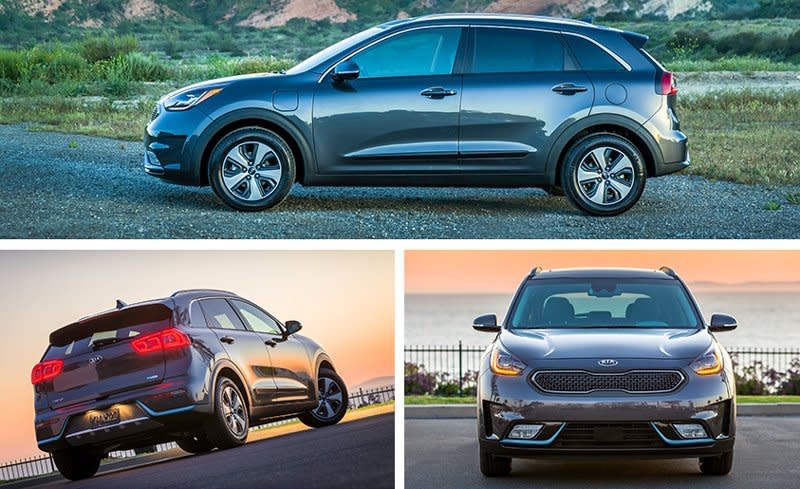
As in the Niro hybrid, an Atkinson-cycle 1.6-liter inline-four achieves a claimed 40 percent thermal efficiency; it’s connected to a six-speed dual-clutch automatic gearbox, with the electric motor connecting to the transmission at its input. A third clutch can connect or disconnect the engine as necessary. The Niro may look like a crossover SUV, but it’s front-wheel drive only.
The Niro plug-in hybrid is quicker to 60 mph than the regular hybrid, according to Kia, as the powertrain improvements more than offset the stated weight gain of 163 to 285 pounds. Its hybrid-mode EPA estimates drop by about 3 mpg overall versus the hybrid to 46 mpg combined, 48 city, and 44 highway, compared with the 50/52/49-mpg ratings for the most efficient versions of the regular hybrid. (In its most luxurious trim, the regular hybrid is rated lower than the plug-in, at 43/46/40 mpg combined/city/highway.) The EPA claims a total range of 560 miles for the plug-in Niro when it has a full gas tank and a full charge.
With sufficient battery charge and when operating as an EV, this Niro is EPA-rated at 105 MPGe combined and can travel 26 miles when powered purely by electricity, but good luck getting that far without having the engine fire up. Press too far into the accelerator and the gasoline engine starts. Click the shift lever into Sport mode, and the engine starts. Turn on the climate control and if you need heat, the engine starts.
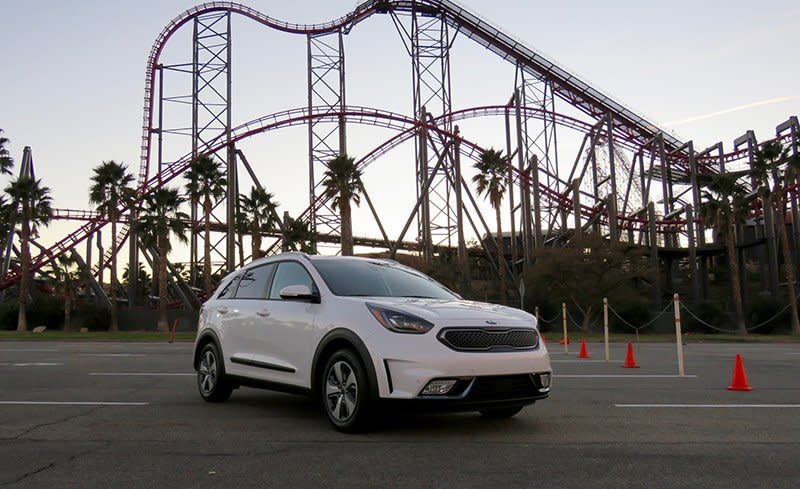
That leads to another point: You won’t find as many of the overtures to all-weather electric driving here as you do in the Toyota Prius Prime, with its heat-pump system, or the Chevrolet Volt, with its resistive heating. Nor can the Niro plug-in hybrid precondition the cabin when the car is plugged in.
Plug It in When You Can
Our first-drive opportunity took place in California—the state slated as the initial sales focus for the model, although it will be available for order throughout the United States—where Kia started us out with a full tank of gasoline but not a full charge, a move that we took as a not-so-subtle statement about how the brand sees this model. On a 498-mile, meandering route from Costa Mesa, California, to San Francisco, we did one recharge at our overnight stop in Paso Robles, which fully topped off the battery. We also plugged in the car briefly at other various stops whenever we easily could do so—about 10 minutes at a time in several instances. Over those many small recharges, we added the equivalent of nearly another full charge—and finished the drive with a trip-computer-indicated 51 mpg. We didn’t have to refill the 11.4-gallon gas tank; at the end of the drive there was an indicated 44 miles of gasoline range remaining.
The driver can select between electric and hybrid modes to tap into the electric driving immediately or to save it for later. Following our one full charge, we covered 24 miles on battery power alone (with the climate control off but the heated seats and steering wheel on) before the system switched back to hybrid mode. Unlike the Kia Optima plug-in hybrid, the Niro PHEV does not include a mode that lets you recharge the battery as you drive.
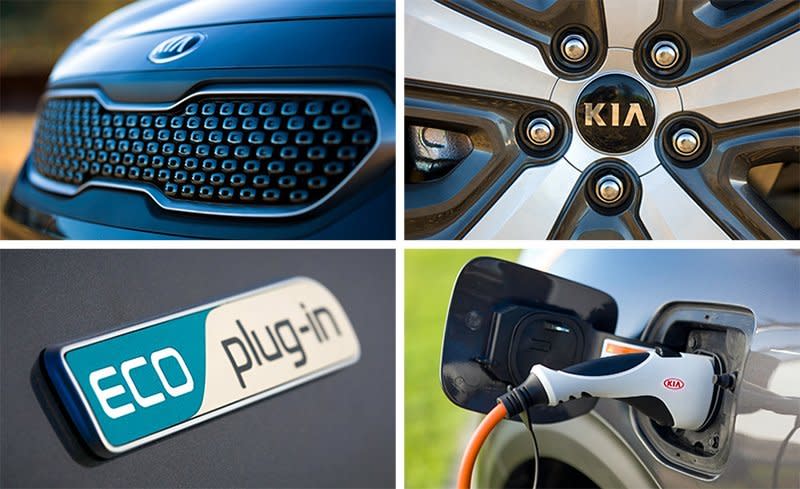
The Niro plug-in hybrid doesn’t sacrifice any livability for its additional electrons. Kia smartly pushed the stepped floor just a bit forward of the lower back-seat cushion to accommodate the larger battery pack under the floor, something that few back-seat occupants would likely ever notice. It has exactly the same hip point for the seat, the same seat cushion, and the same nearly flat seat-folding capability as the hybrid. The only difference is that the fuel tank is a half-gallon smaller.
Just as with the Niro hybrids we've tested, we felt instantly at ease with this vehicle’s slightly elevated seating position, which lands it somewhere between a car and a crossover. It’s high enough to make ingress and egress easy yet not so high that cornering feels awkward. The suspension soaks up bad pavement with decent wheel control and is actually better than in Kia’s other small cars—less harsh than the Forte, less buoyant than the Soul—although there’s a lot of body roll; the low-rolling-resistance tires further discourage you from becoming too exuberant.
There are a few points that could stand improvement in the Niro: The front seats are on the short side. We couldn’t dial up as much regenerative braking as we wanted for long descents down mountain grades. And just as with the Niro hybrid, we encountered occasional awkward drivability hiccups—the consequence of a hybrid system that relies on a single large electric motor to be the go-to for both electric propulsion and regenerative braking, and thus the system is always guessing (sometimes wrongly) what you’re going to do next.
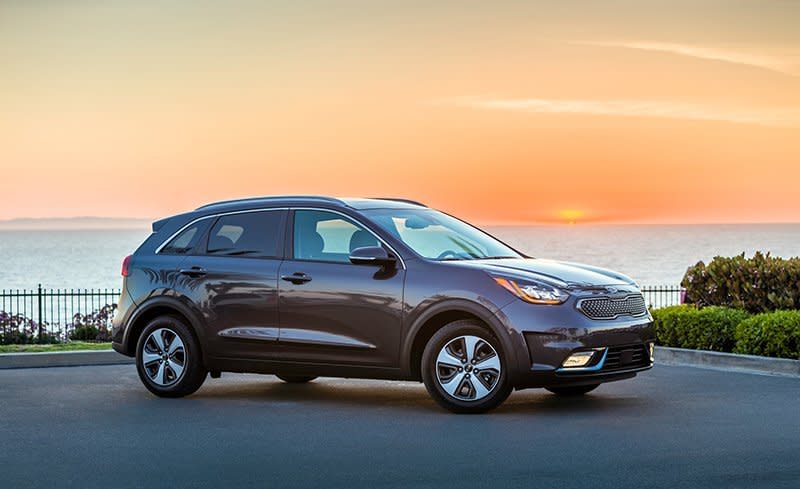
The Volt and the Prius Prime both offer modes that (mostly) lock out the gasoline engine for electric driving, but when the battery is exhausted on those cars the experience becomes less pleasant due to a detached, droning-engine soundtrack. The hybrid system in the Niro doesn’t reward subtlety in a driver’s inputs, but it has a connection between engine and road that most hybrids are missing.
Models and Money
The Niro plug-in hybrid will be offered in LX, EX, and EX Premium trims. Base LX models include a power driver’s seat, dual-zone automatic climate control, lane-keeping assist, adaptive cruise control, and a 7.0-inch touchscreen infotainment interface with Android Auto and Apple CarPlay connectivity. EX models add blind-spot detection and rear cross-traffic alert, plus upgraded upholstery and heated front seats. The top EX Premium, which is what we drove, gets a 7.0-inch display panel in the gauge cluster—adding a tachometer display for Sport mode—plus leather seats, ventilated front seats, a heated steering wheel, a Harman/Kardon audio system, a wireless phone charger, and an 8.0-inch center touchscreen with navigation.
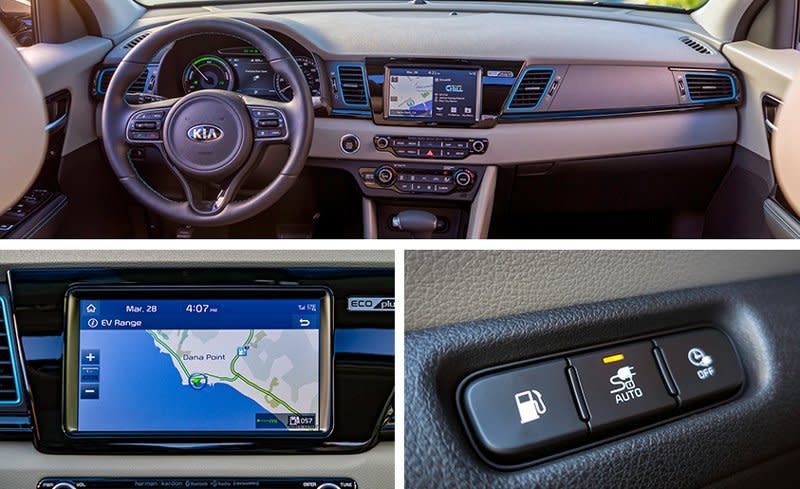
Pricing ranges from $28,840 for the base car, climbs to $32,440 for the EX, and tops out at $35,440 for the EX Premium. While the base price for the Niro hybrid is $24,180, factor in the $4543 federal tax credit for the plug-in and the difference in price between the two all but disappears—and that’s before any additional state incentives that could make the plug-in effectively cheaper.
It’s the inherent practicality and value that sells us on the Niro. It’s no wonder the hybrid has outsold the closely related Hyundai Ioniq by nearly 2.5 to one in the U.S. to date and is gaining on the Prius. With crossover-like seating, space, style, and versatility, there’s no real downside to the plug-in Niro. Charge it a couple of times a week when you can, and you’ll have one of the most efficient vehicles on the market that also can take your family anywhere on the weekend.
Specifications >
VEHICLE TYPE: front-engine, front-motor, front-wheel-drive, 5-passenger, 4-door hatchback
BASE PRICES: LX, $28,840;
EX, $32,440;
EX Premium $35,440
ENGINE TYPE: DOHC 16-valve Atkinson-cycle 1.6-liter inline-4, 104 hp, 109 lb-ft; permanent-magnet synchronous AC motor, 60 hp, 125 lb-ft; combined output, 139 hp, 195 lb-ft; 8.9-kWh lithium-ion battery pack
TRANSMISSION: 6-speed dual-clutch automatic with manual shifting mode
DIMENSIONS:
Wheelbase: 106.3 in
Length: 171.5 in
Width: 71.1 in Height: 60.8 in
Passenger volume: 101 cu ft
Cargo volume: 19 cu ft
Curb weight (C/D est): 3400–3500 lb
PERFORMANCE (C/D EST):
Zero to 60 mph: 9.0 sec
Zero to 100 mph: 31.0 sec
Standing ¼-mile: 17.3 sec
Top speed: 107 mph
EPA FUEL ECONOMY:
Combined/city/highway: 46/48/44 mpg
Combined gasoline+electricity: 105 MPGe

 Yahoo Autos
Yahoo Autos 